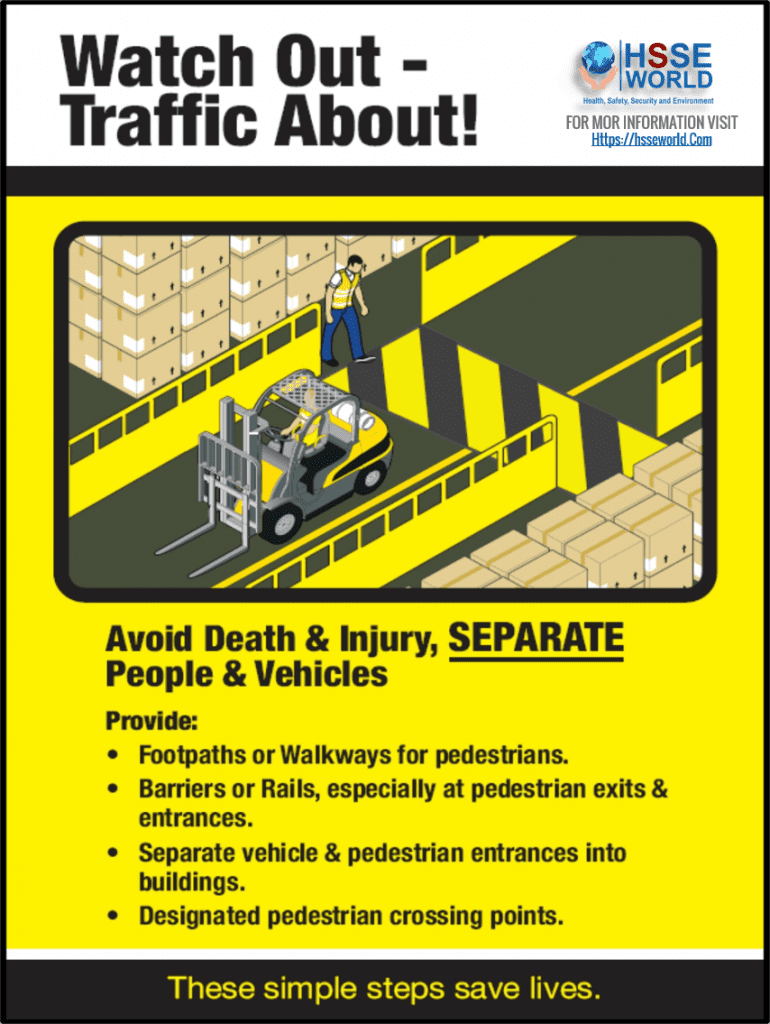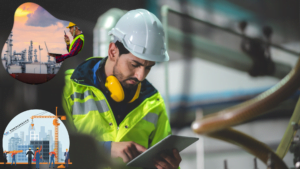Pedestrian safety in the industry
6 min readEmployees can easily recognize the hazards associated with material handling, welding, machine operation, electrical work, and other dangerous job tasks, but they tend to overlook more common hazards that affect everyone. Some of these common hazards affect a lot of people with a wide variety of job descriptions, but these employees all share a common job title when it comes to these particular hazards: pedestrian. More than 25 million workers suffer some type of injury while walking at work each year. Like other on-the-job injuries, these incidents can be prevented.
This article shows employees the precautions they must take to avoid incidents while walking. Topics include awareness of walking hazards, workplace signs, slips, and falls, walking around material handling equipment, overhead hazards, and traveling through parking lots.
Awareness of hazards
Pedestrians often put themselves at risk by not being fully aware of the potential hazards around them. These hazards can include moving forklifts, slippery floors, tripping hazards, overhead loads, and even cars in parking lots. All are potential hazards an unaware pedestrian may easily walk into simply by being unfamiliar with the specific hazards of the area.
Before entering or passing through work areas, find out about specific hazards to avoid and stay alert for those hazards.
Being prepared includes having the proper clothing, protective equipment, and knowledge to keep you safe in the areas you plan to travel.
Some areas require specific types and styles of clothing such as long sleeve shirts, steel-toed boots, or chemical-resistant coveralls.
Personal protective equipment is also required when passing through certain areas. Practically all
Industrial, construction, or manufacturing areas require safety glasses to be worn at all times.
Other areas may require a hard hat or an emergency respirator.
Don’t use the excuse of just passing through as a reason to be unaware or unprepared for work area hazards.
Workplace signs
One way to always be prepared is to pay attention to workplace signs and take their messages seriously.
Workplace signs are found in various styles and colors to communicate different types of safety information. Their messages are generally divided into cautions, dangers, and warnings.
Caution signs are safety yellow with black graphics and texts. These signs caution against unsafe practices that could result in minor or moderate injury.
Danger signs have black text on a white background and feature the red and white danger symbol. They warn of a serious hazard that will cause injury or death if not avoided.
Danger signs represent a more serious hazard than caution signs.
Warning signs represent an extreme hazard. These signs feature an orange background with black text and graphics.
(Download free signs from here )
Warning signs are used to convey critical instructions that save lives.
Pedestrians also need to be aware of lights, symbols, alarms, or other methods used to communicate hazard information.
Of course, just understanding the warning is not enough. The message must be followed. Disregarding these important messages is like walking through a minefield, each step a potential disaster.
You can download our poster from here. Download
Slips, trips & falls
When pedestrians are caught by unexpected hazards, the result is usually a slip, trip, or fall. Slips, trips, and falls account for more than half of all pedestrian incidents.
To avoid becoming a fall statistic, we must learn to expect the unexpected.
Be alert to the condition of the surface on which you are traveling. Expect that it will have tripping hazards until you visually verify that it does not.
When approaching intersections, expect oncoming traffic until you make sure the way is clear.
When using stairs, expect obstacles in your path until you see otherwise.
When entering bathrooms, locker rooms, or other frequently mopped areas, expect the floor to be wet and slippery.
If you discover a hazard while traveling through the facility, correct the hazard or report it to the Proper authority so it can be resolved as soon as possible.
Don’t leave fall hazards for other pedestrians to discover.
When walking up or downstairs, use the handrail whenever possible. Take one step at a time and be certain of your footing when reaching the last step.
Make sure there is sufficient light in an area before entering. You can’t avoid the hazards if you can’t see where you’re going. Don’t run at work. Running at work is unsafe and often leads to a fall. ( Read more: slips-trips-and-falls-prevention/)
Walkways and aisle ways
Many areas have designated aisle ways and walkways. Pedestrians should stay inside these marked areas whenever possible.
Marked aisle ways are designed to keep pedestrians a safe distance from the hazards of machinery, equipment, and the manufacturing process.
By staying inside the walkway, rather than taking shortcuts through production areas, many workplace hazards can be avoided.
( learn more: floor-marking-best-practices/)
Material handling equipment
We must share aisle ways with a variety of material handling equipment. This equipment, while vital to the operation of the facility, presents a serious danger to pedestrians.
Some work areas have large numbers of forklifts, order pickers, powered pallet jacks, or other material handling equipment, while others seldom use this type of equipment.
Always stay alert for vehicle traffic. Many doors, aisles, corners, or storage areas open into busy
Aisle ways with little warning.
To avoid stepping in front of a moving vehicle, approach intersections cautiously and be sure the path is clear before entering.
Pedestrians have difficulty determining which way this type of equipment will move next. Because they often move backward when you expect them to move forward, never walk or stand directly behind these vehicles.
Since rear-wheel steering allows sharp turns with a tight turning radius, never stand so close that a sudden turn by the vehicle could cause it to hit you.
Keep in mind that the forks of a lift truck extend in front of the vehicle and are kept low to the ground While traveling or when parked. This creates a tripping hazard.
Always locate the position of the forks when traveling near this equipment so you can stay clear of them.
Always assume the operator of moving equipment cannot see you. A safe rule of thumb is to always maintain a distance of a least one-vehicle length from these machines.
Overhead hazards
Industrial, construction, chemical, and manufacturing operations have a variety of overhead hazards that may place a pedestrian at risk.
Many areas use overhead cranes to move materials from place to place. At times, these cranes may cross over the path of pedestrians.
If you see a raised or moving load, stay clear. Never walk beneath a suspended load.
Raised working surfaces such as scaffolds, aerial work platforms, and ladders present an overhead hazard to those below them. Falling material or tools can also cause a serious injury.
Raised loads of material handling equipment are also hazardous to pedestrians. The loads commonly shift and fall.
If you encounter a raised load while traveling, wait for it to clear or find an alternative route. Never walk under a raised load.
Parking lots
Parking lots present many of the same hazards found inside the workplace. Trip and fall hazards such as potholes, gravel, and parking dividers frequently trip up pedestrians.
Slipping hazards include oil and other fluids that may leak out from vehicles. In the winter, patches of ice create needless injuries.
When pedestrians are near moving vehicles, an increased awareness must be maintained to prevent collisions. Always assume drivers cannot see you.
When traveling in parking lots, be alert for cars backing out. Keep a watch for brake lights and backup lights, which may indicate a vehicle is about to move.
Don’t stand or walk directly behind parked cars. Allow room for other drivers to see you.
Be wary of large trucks and vans. These vehicles have large blind spots that can completely block a Pedestrian from the driver’s view.
When approaching large vehicles, be alert. A smaller vehicle may suddenly pull out from behind the larger one.
Always look before stepping from between cars.
Never run while in the parking lot. Running places, you at extreme risk.





